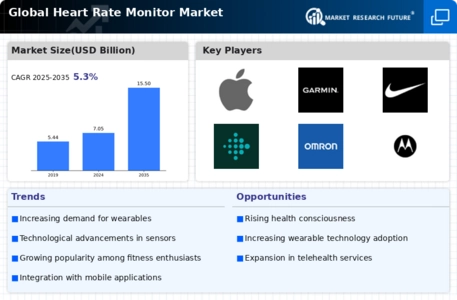Market Share
Heart Rate Monitor Market Share Analysis
The Heart Rate Monitor market dynamics showcase a thriving landscape driven by the increasing focus on personal health and fitness, technological advancements, and a growing awareness of cardiovascular health. Heart Rate Monitors, which measure and display an individual's heart rate in real-time, have become integral tools for fitness enthusiasts, athletes, and individuals aiming to monitor their cardiovascular health. One key driver of the market is the rising global prevalence of lifestyle-related diseases and the growing emphasis on preventive healthcare. As people become more conscious of the importance of maintaining a healthy heart, the demand for heart rate monitoring devices has surged, influencing the market dynamics significantly.Technological innovation is a central force shaping the Heart Rate Monitor market dynamics. Continuous advancements in sensor technology, wearable devices, and connectivity options have resulted in the development of highly accurate and user-friendly heart rate monitoring solutions. The integration of these monitors into smartwatches, fitness trackers, and other wearable devices has expanded their accessibility, making heart rate monitoring a seamless part of daily life for many individuals. The evolution of technology not only enhances the accuracy of heart rate data but also provides users with valuable insights into their overall fitness and well-being.
Consumer preferences and behavior contribute to the dynamic nature of the Heart Rate Monitor market. The increasing adoption of a holistic approach to health, including regular exercise and wellness monitoring, has led to a surge in demand for multifunctional devices that go beyond basic heart rate tracking. Consumers seek features such as sleep tracking, activity analysis, and integration with fitness apps to gain a comprehensive understanding of their health. This demand for integrated and versatile solutions influences the market dynamics, prompting manufacturers to develop increasingly sophisticated and feature-rich heart rate monitoring devices.
The competitive landscape also plays a vital role in shaping the Heart Rate Monitor market dynamics. The market is characterized by a multitude of players ranging from established tech giants to specialized fitness device manufacturers. Intense competition fosters continuous innovation and drives companies to differentiate their products through unique features, design, and pricing strategies. This competition benefits consumers by offering a diverse range of options and pushing manufacturers to deliver high-performance and cost-effective heart rate monitoring solutions.
Health and fitness awareness programs, along with corporate wellness initiatives, contribute to the expanding market dynamics of Heart Rate Monitors. As employers and individuals alike recognize the importance of maintaining good health, there is a growing trend of incorporating wearable health technology, including heart rate monitors, into workplace wellness programs. This integration aims to promote a healthier lifestyle, reduce the risk of cardiovascular diseases, and enhance overall employee well-being, thus contributing to the growth of the Heart Rate Monitor market.
Regulatory considerations and standards also influence the market dynamics of Heart Rate Monitors. Compliance with health and safety regulations ensures the quality, accuracy, and reliability of heart rate monitoring devices. As consumers increasingly rely on these devices for health-related decisions, adherence to regulatory requirements becomes a crucial factor in maintaining trust and credibility within the market.
Economic factors, including disposable income and healthcare spending, play a role in shaping the Heart Rate Monitor market dynamics. The affordability of heart rate monitoring devices and related accessories influences consumer purchasing decisions. Additionally, as healthcare systems and insurance providers recognize the potential benefits of preventive health measures, there may be increased support for the adoption of heart rate monitors as tools for early detection and management of cardiovascular issues.



















Leave a Comment